12 More Advanced Core Stability Exercises for Children with Cerebral Palsy
Core stability refers to the strength in the muscles of the abdominals and back, and the amount of control and balance between them. Our core supports our arms and legs, and we need stability in it to do a range of physical tasks.
Many children with Cerebral Palsy will have a weak core – either because of high tone, low tone or a lack of movement opportunities.
Here, we share some more activities to help our children develop their core strength and stability. If these exercises feel too challenging, we also have an introductory core series.
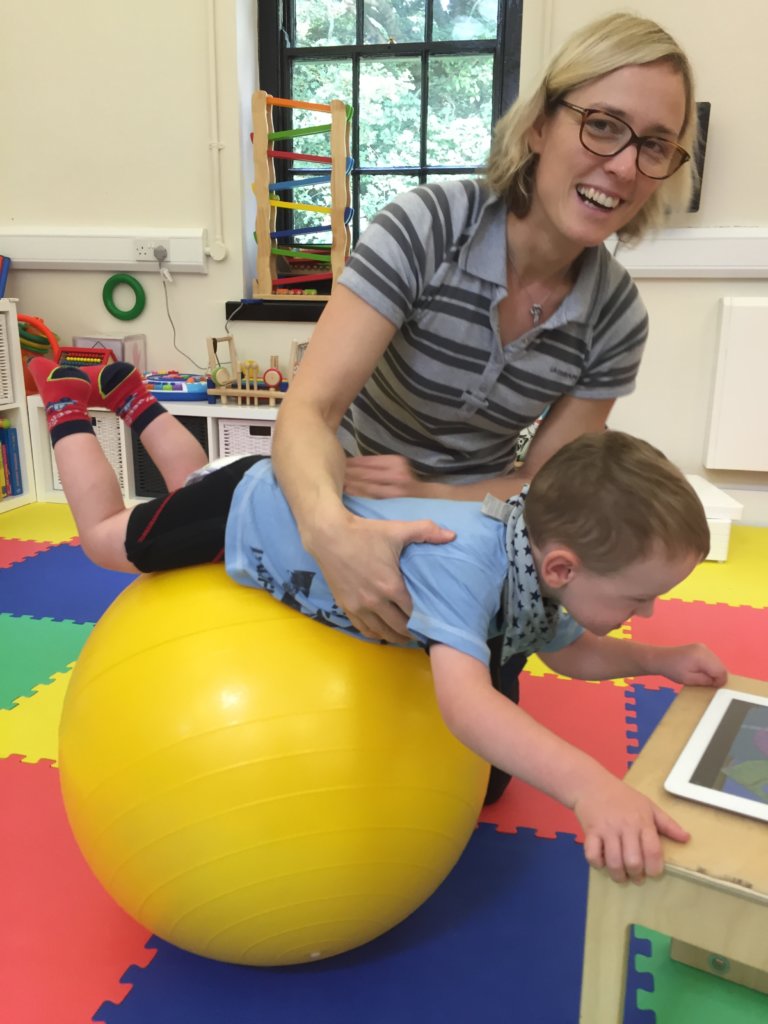
Core stability is key to the workings of our whole body. If we have good core stability, our arms and legs will work better as they are attached to a stable base.
Fine and gross motor (movement) skills are easier to master if we have a strong core.
A stable core allows us to balance in different positions. It enables us to stay still and balanced while our arms and legs work (e.g. walking) or to stay upright when we are on a moving surface (e.g. a bus).
Because our bodies are constantly seeking balance, having a good core increases our ability to focus and concentrate. It is easier to attend to a task if we are able to sit still.
If your child’s muscles are weak, if one muscle is weaker than the other, or if the messages the brain sends to the muscles tells them to work too hard or not hard enough (high tone/low tone), then it is possible that your child will have poor core stability, affecting their other movement skills. This is very common with Cerebral Palsy as it is rare for the core to be completely unaffected.
A child who is mobile on the floor may have some core stability but move in fairly two dimensional ways (forward and back or side to side but not much rotation/twisting). Without rotation, it is not possible to have full core stability as rotation is a core element of full control.
A good core is a great for everyone so working through these activities will be helpful even if your child doesn’t display any particular difficulties.
Here are some core stability exercises to work through with your child. Go down the list and find the first level that they would find a little difficult. This is your starting point. Enjoy that activity until they can manage it well. If they can’t manage a certain activity, move them back a section or move onto the next section. You can be practicing several exercises/ activities in the same session to be more effective.
Make sure your child is successful in their game as this will motivate them to continue. As you push them to get to the next level, they should be able to manage a few of their attempts to keep motivated – even if they are not successful at all of them.
Remember to praise the effort made rather than the result achieved. This will motivate your child to persevere with an activity and not be put off if they don’t succeed at first.
Advanced exercises to strengthen and refine core stability
Rolling is key to incorporate those rotation muscles.
Your child may need a little help to free their arms and legs but use toys to motivate them to roll over.
Make sure they bend their legs as they roll over rather than rolling in 1 block. Encourage them to roll with their legs first and then follow with their body to make sure they get as much rotation in their trunk as possible.
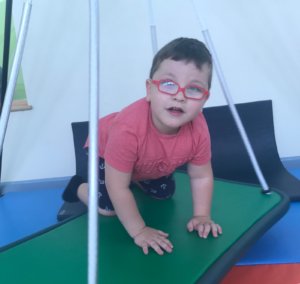
This is a brilliant activity for the core. Every time your child moves, their core has to stabilise to allow your child to lift an arm or leg. In some situations, your therapist may have advised not to do crawling so make sure you follow their advice.
1. Try to encourage 1 leg and then the other rather than moving both legs at the same time.
2. To challenge the core further, practice crawling over objects or even up some steps. Set up an obstacle course (see our ‘Our Home’ video) to challenge them further and for lots of fun.
NB. If your child has very high tone in their arms and legs and isnt at the standing stage, crawling may make their hips tighter in time. If you aren’t sure, peak to your Physiotherapist before encouraging crawling.
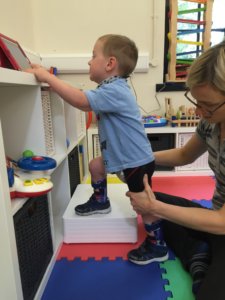
Once your child is pulling up to standing at furniture, try challenging their balance by standing them on a wobble cushion (a cushion filled with air) or use a sofa cushion to challenge their core a bit more. You could also try standing with 1 foot on a raised surface (a big book or box) to challenge them further.
Ask them to reach to the side and down to pick up objects/ hit a drum/ post an object in a container etc.
Pushing a trolley, cruising along furniture and standing with their backs to the wall are also lovely exercises to strengthen the core before a child can walk on their own.
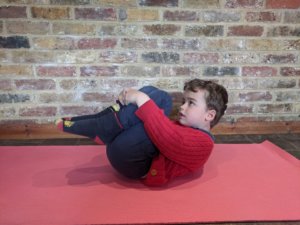
These exercises are fabulous for strengthening the tummy muscles.
First, ask your child to lie on their back and lift their legs to their chest and hold on to their knees with their arms. See if they can lift their head and hold up to 20 seconds in the ball shape without rolling over or dropping their head.
Try playing ball in this position. Your child should keep their knees up but hold a ball behind their head and then throw it towards you standing at their feet end. Next, hold the ball above your child’s feet for them to come and pick it up again. This mimics a sit up.
In the same position, throw a ball in the air and your child needs to kick the ball up in the air back to you with both feet.
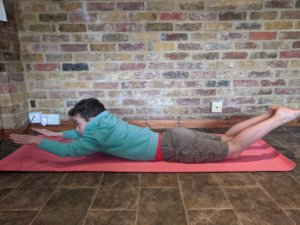
Help your child to lie flat on their tummy with arms up in front of them and legs straight behind them. Encourage them to lift their arms and head up off the floor and hold for 20 seconds.
Next try to lift just their legs and hold for 20 seconds.
And now try to lift arms and legs at the same time. This may be easier over a gym ball.
You could ask them to roll a ball back and forward out in front of them from this position as a rolling game or to knock down some skittles.
Your child should lie on their back with their feet on a gym/physio ball or on a cushion if there is no ball available against the wall. Move the cushion/ ball up and down the wall and then side to side. Try drawing a picture or writing their name.
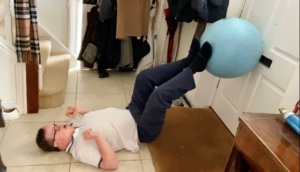
Lying on their back with their feet on the ball. The child should try to keep the ball still while you try to move it side to side.
These exercises strengthens the bottom which is the crucial to enable full core stability.
Lie your child on their back with their knees bent and feet on the floor or on your lap. Encourage them to lift 1 leg in the air with a straight knee or crossed over the other leg. Now lift their bottom and ask them to try to keep their bottom up for 20 seconds with their hips staying level.
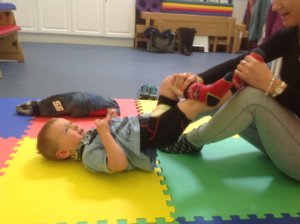
Lying on their back with their knees bent and 1 leg up. Lift their bottom and try lowering their straight leg down and up again. (The straight leg shouldn’t go lower than the other knee).
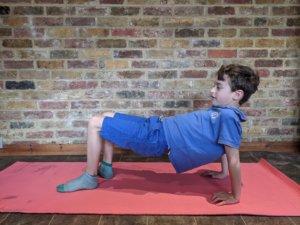
Sat on the floor and with their hands out behind them, facing their feet and with their knees bent (feet on the floor). Encourage your child to lift their bottom up and hold it so they make the shape of a table.
Try walking around like this.
Make it more challenging by balancing a toy or even a ball on their tummy while they walk around in all directions.
They could pretend to be different animals and make a game of it – try being a snake on the floor, or bear walk on hands and feet, or kangaroo jumps. Make an obstacle course and challenge your child to complete it as different animals.
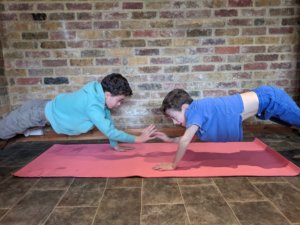
Get your child to lie on their tummy and put their hands at chest level. Help them to push up so that their weight is just on their hands and their toes. Get them to hold this position for as long as they can. Make sure their bottom isn’t up in the air but that you also aren’t letting their tummy sag down. Drive some cars under them to encourage the child to keep it up.
Do this facing a sibling and try clapping 1 of their hands to one of their sibling’s hands. See how many claps your child can do – try to get to 20 claps.
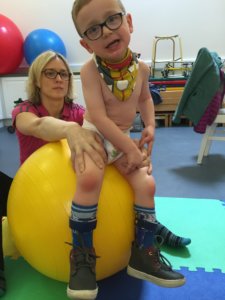
These should be done with help from an adult to make sure they are safe.
Sit your child on a gym ball and try and balance while they move their bottom around.
Get them to lift 1 foot off the floor and keep balancing.
Get them to try and lift both feet off the floor.
Get them to roll over the ball on their tummy until their hands reach the floor. Keep them walking forward on their hands until only their feet are still on the ball. Walk backwards until they are fully back on the ball. You can make this more interesting by picking up puzzle pieces and doing a puzzle or by picking up beanbags to throw into a bucket.
Get them to lie on their back on the gym ball. Hold your child’s feet as they reach for an object on the floor behind the ball. Ask the child to bring the object back up so they come into sitting to throw the object into a container.
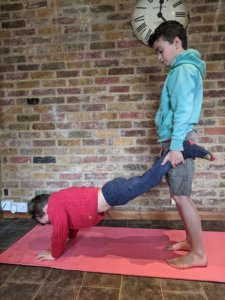
Hold your child by their hips with their legs straddling you and their hands on the floor. Move around the floor picking up objects for as far as you can go.
Move your hands down to your child’s knees and walk around the room – picking up objects or playing a matching game or skittles.
If you can, hold your child by their ankles. Make sure they keep their bottom in the air and don’t hang their tummy’s down. Again find a game to make this more entertaining.
As your child gets stronger you could try to get from one end of the house to another – even trying going up the stairs.
You could also make an obstacle course to go around.
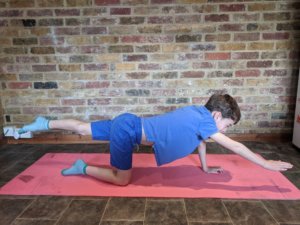
On their hands and knees – reach 1 arm straight out in front of them in the air – you can challenge them to balance a beanbag or soft toy on the back of their hand to keep it up. Try and hold for 1 minute.
Now try and lift 1 leg straight out behind them. Try and hold this for 1 minute.
Can they do an opposite arm and leg at the same time and hold it for 1 minute?
Try the other side.






